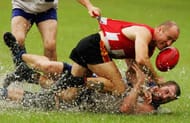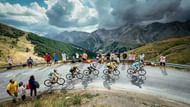For many of us, 'exhaustion' is a feeling of fatigue that we get after a particularly hard day's work. That feeling is almost invariably cured by a good night's sleep, which is usually enough to replenish the depleted reserves of the body and soothe the muscles.
But it doesn't quite work that way in the case of the draining, punishing, excruciating fatigue that professional athletes face.
The exhaustion experienced by athletes often goes beyond the point when the muscles put up the white flag. Professional sports push you beyond the point of physical depletion, and challenge you to sink or swim.
But are all sports equally exhausting? The obvious answer is no. That logically leads us to another question: which is the most exhausting sport of all?
There are multiple ways of deciding that. Calorie expenditure would be one measure, while loss of body fluid and duration of play can also indicate how hard your body is working.
Here's an in-depth, scientific look at the top 10 most exhausting high-profile sports in the world:
Honourable mentions
Tennis
Until you have gone a few sets on the court, it is difficult to appreciate how physically taxing tennis can be. You only have to look at the epic six-hour battle between Novak Djokovic and Rafael Nadal in the final of the 2012 Australian Open to understand the insane demands of tennis.
The only reason tennis isn't higher on this list is because of the numerous short breaks the players enjoy between points, games and sets. Moreover, most of the matches don't go the distance the way that Nadal-Djokovic marathon did.
At the US Open in 2014, the average length of a match was 2 hours and 44 minutes. On grass, the duration is even shorter; the average duration of the men's final at Wimbledon from 1980 to 2006 was 2 hours and 31 minutes. The clincher is that the ball is in play for less than 20% of any tennis match.
Even if we take 20% of 2:44 as the duration of play, it works out to 32.8 minutes. On average, a player would burn 270 calories while playing a tennis match.
Football
It may seem strange to see football outside the top 10, but the fact remains that the players always enjoy ample downtime, where they are just jogging lightly, compared to other sports on this list. Although some footballers can be seen covering seven miles a game based on the position they play, there is plenty of lax time on the field.
Still, those 90 minutes can be hellishly excruciating, and players have been known to burn up to 1,050 calories and lose a couple of kilograms of body fluid weight during football matches.
Having got the honourable mentions out of the way, here’s a countdown of the 10 most exhausting sports:
10. Rowing
How tiring can a sport be if it requires you to sit for the entire duration? The answer: dizzyingly exhausting.
Rowing is like sitting in a meat grinder. You churn your arms like rusty blades on clunky fulcrums, which disembowel your interiors with each stroke.
In his book The Shell Game: Reflections on Rowing and the Pursuit of Excellence, Stephen Kiesling credits the introduction of sliding seats with turning rowing into full body torture. He says, "By integrating the legs and stomach with the back and arms, all of the major muscle groups were harnessed. If one wanted to lay waste to all the energy in the body in the shortest possible time, rowing would be the way to do it.”
Most exhausting sports ask you to push your body to the limit, while allowing you crawl space to continue even after your tank is empty. If you were to lift a heavy set of dumbbells set after set, your arms would stop responding after a while. But swinging an oar is just tough enough below the threshold of failure that you can continue to row while setting your sinews on fire.
Here's what Olympic legend Matthew Pinsett has to say on the rigours of rowing: "Your senses are not in control anymore and they start to leave you. The hearing will go, the vision goes out of sync, there isn't much left. Your body starts to close down anything it doesn't need at that moment. It prioritizes to the parts of the body that are in trouble, like your muscles suffering the agony of the row."
In rowing, the 'sprint' races are 2 kilometres long, while the longer races last 5 km. It takes about 5-7 minutes to row a sprint of 2 km, which is faster than most people can run that distance. Over that length, your life begins to flash before your eyes.

Pretty much every muscle group plays a part in rowing. Even though you use your arms to row, the rest of the body is involved in anchoring yourself to the boat and establishing fulcrum for a row. It's been claimed that about 60% of the power involved in rowing comes from the legs.
The rowing motion also compresses your lungs, adding to the difficulty of breathing. It's been remarked that participating in a 2 km rowing race can leave you as drained as playing two basketball games back to back. A professional rower needs to consume over 6,000 calories every day to meet the demands of the sport.
The repetitive motion in rowing fills your muscles with lactic acid, which in turn is converted into ammonia, giving you humongous headaches. It is not uncommon to see rowers throwing up at the finish line and appearing dizzy and disoriented.
Professional rower Ashleigh Teitel describes the hell of rowing thus: "An abyss of pain, which opens up in the second minute of the race. Large needles are being driven into your thigh muscles, while your forearms seem to be splitting. Then the pain becomes confused and disorganized, not like the windedness of the runner or the leg burn of the biker but an all-over, savage unpleasantness.”
In addition to the shorter 2,000-metre rowing races which are the standard for the Olympics and bitingly painful in their own right, there are some other mind-boggling rowing races which can wring the consciousness out of your body. The Tour du Lac in Geneva, Switzerland is one such example. It's a 160-kilometre long journey of pain – the longest non-stop rowing race in the world. Teams routinely take around 12 hours to complete it, and you can imagine the difficulties of refueling and relieving oneself while rowing around Lake Geneva.
If that isn't exhausting enough, try the Great Pacific Race for fun. This is by far the most challenging endurance race of any kind on our planet, covering 3,862 kilometres without any support, and it can take between 30 to 80 days to complete. Wind and other variables can result in the distance increasing as the boats veer off course, and the journey will leave you drained unlike any other sports event on earth.
Calories burnt per minute: 14
Sweat loss per minute: 0.03 litres
Duration: 8 minutes (much longer for non-Olympic races)
9. Water Polo
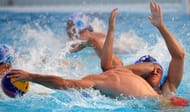
At first glance, water polo seems like one of the most relaxed sports around. We see 14 players wading around in a smallish pool, looking slow as snails as they try to cut through the water and score.
But mistaking water polo for a fun frolic in the pool is as erroneous as mistaking the tip of an iceberg to be a mild speed bump for a ship. Much like an iceberg, which hides over 80% of its girth underwater, water polo is a brutal blood bowl of survival in the water, where seven well-trained sharks try to rend you asunder.
A number of factors contribute to making water polo so exhausting. The very rules of the game are designed to maximize fatigue: you cannot stop pedalling for even a second when the game is on, as you can't touch the floor or the sides of the pool when the ball is in play. So the players have to constantly pedal to stay afloat, which in itself would make it a punishing exercise.
The game features a 30-second shot clock, during which the teams have to attempt a shot or forfeit possession. The players aren't allowed to wear goggles or any protective gear, as that might hurt their opponents. Only earplugs are allowed.
It doesn’t help that the activities take place in water. When placed underwater, the human body spends a lot of energy in maintaining equilibrium temperature. If the water is too cool, it can reduce the blood flow in your body and cause the muscles to get strained. That forces the body to spend energy to keep warm. Conversely, if the pool is warm, it can increase fatigue. A lot of the pools also have liberal amounts of chlorine, which can cause fatigue by restricting breathing.
Playing water polo can feel like being thrown into a giant washing machine, with sharp blades that smack you around while you try not to drown. One of the most violent sports in the world, which is deceptively disguised as a benign exercise, water polo allows the participants to inflict untold amount of pain on their opponents.
The players surreptitiously punch, kick, claw, scratch and try to dunk the opponent underwater. Often, they don't even bother being surreptitious. There are very few other sports which allow for so many underhand shenanigans.
Water polo players have been known to pull on each other's armpit hair, whack their opponent under the guise of swimming strokes, pull on the ear guard strap or swimming trunks, have a go below the belt, punch the throat to restrict breathing – the list goes on.
Bones are broken, eyes are gouged out and concussions are distributed like candy. It is common to see players with purple bruises all over their body, looking like the missus caught them cheating and had a roller handy.
In an infamous battle between Hungary and USSR at the 1956 Olympics, proceedings got so heated with punches and kicks that the match came to be known as 'Blood in the Water'. Water polo is a brutal, painful, exhausting and gut-wrenching sport, whichever way you look at it.
Calories burnt per minute: 11.7
Sweat loss per minute: 0.01 litres
Duration: 32 minutes
8. Basketball
Basketball, when it’s played the way it’s meant to be, is like a levitating orchestra – with the players' feet barely skimming the ground while they float above the earth for 40 hard minutes. It is one of the fastest team sports played on solid ground, involving an incredible amount of straight sprints, jumps, lunges and contact at a very fast pace.
Technically, it is a non-contact sport. But anyone who's seen or played the sport knows that that classification is a bit of a joke. No sport presents you with the prospect of such a variety of injuries as basketball does. From overuse injuries, tendonitis, ACL tears and bursitis to sprains, fractures, cramps and ligament tears, the list is endless.
Fatigue contributes heavily towards injuries; when the body overcompensates for depleted energy levels, it becomes more vulnerable to damage. Basketball players can have vertical leaps measuring over 30 inches, and most of them are above 6"4 in height. That makes for some explosive action on the court, which can be brutally exhausting.
In a study published recently by Sports Illustrated, LeBron James beat Cristiano Ronaldo and Usain Bolt to be named the fittest athlete across all sports. Basketball requires an extremely well-toned cardiovascular system, explosive anaerobic power, ample muscular strength and endurance, and low body fat.
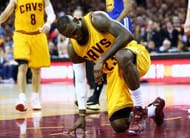
Players like LeBron and Russell Westbrook rely a lot on their explosive fitness to dominate the competition, and they often have to push themselves beyond the point of exhaustion. Dribbling, shooting, playing defence, etc all involve using the upper and lower body in tandem. And that's not to mention sprinting up and down the court without respite.
The sprints don't stop once the players reach one end of the court either. Watching a player like JJ Redick run around in the half-court is exhausting by itself.
If you observe the training habits of some of the players, you'll be forced to question the humanity of the punishing ordeal they put themselves through. From Kobe Bryant going on 40-mile-long midnight cycle rides through the desert, to Blake Griffin climbing sand hills with weight vests, the players undergo brutal training regimens to cope with the demands of the sport.
Let's take a look at the players who cover the most ground during matches. Luol Deng covered 2.72 miles per game in the 2012 season, and Jimmy Butler covered the same amount in the 2015 season. That translates to 4.3 km.
Now, the basketball court is 94 feet long, translating to 28 metres. If Deng and Butler cover 4.3 km per game, that must be equal to 153 trips up and down the basketball court, most of it covered in sprints, all within a space of just 48 minutes. Moreover, a lot of the distance covered is with a defender being glued to your hip or with you shadowing another player at whose whims and jukes you have to change direction.
There's a good reason you see basketball players looking winded and soaked in sweat all the time.
Calories burnt per minute: 9.37
Sweat loss per minute: 0.02 litres
Duration: 40 minutes
7. Boxing
There is a world of physical pain and punishment awaiting a boxer within that 20 square feet purgatory enclosed by four parallel ropes.
Boxing is generally considered to be more of a bruising sport than an exhausting one. But as it turns out, performing an intense cardio session while plummeting a well-conditioned machine and trying to avoid getting beaten to a pulp makes for a shockingly draining workout.
A study analyzing seven Olympic boxers showed that their peak punching force ranged from 447 to 1,066 pounds. Another study involving 70 boxers showed that they hit with an average of 776 pounds of force. 1985 World Boxing Council heavyweight champion Frank Bruno could throw a punch with a force of 1,420 pounds, which if connected with the head of an unfortunate opponent would send the latter reeling at a rate of 53 g, i.e. 53 times the force of gravity.
There is no mitigating the effect of such well-trained blows raining down on your person.
Before the powers that be decided on a 12-round limit, matches could go on indefinitely; until 1867, boxing would have been a lot higher on this list. The Marquess of Queensberry rules helped bring the rounds down to 12 and set the duration at 3 minutes per round. There's generally a one-minute break between the rounds.
A boxing match can also get over in fewer than 12 rounds in case of a knockout or if one of the fighters is unable to continue. That's a total maximum duration of 36 explosive minutes of timed action in which the fighters expend every ounce of their energy.
How many punches can be thrown in a round of three minutes? In the 12th round of a fight between Vince Phillips and Ray Oliveria in 2000, the two fighters were so tired that they barely bothered to dodge punches. Instead, both plugged away with the last remnants of their stamina while absorbing body blows. They threw a combined 463 punches in that round.
Boxing is not just about how hard you can hit; it’s also about how hard you can get hit and then choose to get hit again, and again, and again. It's a test of how much risk of permanent bodily harm you can take.
In times of stress, people are encouraged to take deep breaths. Even panic attacks can be calmed by breathing deeply. And a really quick way to get exhausted is to interrupt your breathing.
When you take a hit in boxing, your breathing gets interrupted and your muscles get compromised, so there is almost constant cause for exhaustion in the sport. Moreover, in the case of a punch to the head, the brain comes into contact with the skull and gets twisted. There is risk of brain haemorrhage, detached retinas, concussions – the list goes on.
Nothing tires you out as quickly as a full blown sprint or a suicide drill. Boxing involves a number of sprinting lunges, all taking place while the upper body performs a strong set of cardio. Each movement can require you to expend close to the maximum energy possible as you dodge, bob and weave and throw punches.
Boxing can leave you battered, bruised, gasping for breath, disoriented and uncertain about the purpose of your existence.
Calories burnt per minute: 14.5
Sweat loss per minute: 0.03 litres
Duration: 32 minutes
6. Australian Rules Football
To the layman's eye, rugby, American football (National Football League, USA) and Australian Rules Football (Australian Football League, Australia) seem homogeneous to a large degree. What all three sports have in common is the objective of striking your opponents hard, with the aim to floor them.
But the technicalities of the three sports present a stark contrast, and a process of elimination can help us determine which of the three is the most exhausting.
NFL
There's no question that NFL athletes are way more powerful than their counterparts in the AFL and rugby, but that is because they need to prepare for action in short bursts.
The actual time when the ball is in play in an NFL game is barely 11 minutes. While there is a world of pain packed in those 11 minutes, it doesn't compare with Australian rules and rugby. On an average, an NFL player covers about 2 km per game.
Australian rules and rugby involve minimal protective equipment compared to the NFL, and both those sports require the athletes to cover way more ground while colliding with muscular, rhino-skinned warriors.
Rugby vs Australian rules
A rugby player can cover between 4.5 to 6.8 km in a match on an average, while spending roughly 75 to 91 minutes on the field. Compared to that, an Australian rules player can cover between 10 to 18 km per game and burn over 1,000 calories per hour.
A rugby match lasts for 80 minutes, divided into two halves. The AFL has 20-minute quarters, but it places more aerobic demands on the athletes.
In Aussie rules, you can only pass the ball by kicking or punching. And the players need to constantly run for their lives while evading tackles, leaping for catches (or taking a mark, as the parlance has it), torpedoing into tackles, breaking tackles and traversing a field way larger than a football field.
(An AFL field can be between 135-185 metres long between the goals and 110-155 metres between the sides. In contrast, a football field is just about 105 metres long and 68 metres wide).
The AFL also has tremendous potential for violence, with tackles being allowed on the player who has the ball. Players are also allowed to use force to prevent their opponents from tackling their team members. That rule has wide room for interpretation, and teams use every bit of their imagination to perform the most painful contact they can get away with.
Each of these three sports involves explosive, hard collisions between colossal, sprinting masses of muscle. The NFL features the hardest hits, but has minimal on-field action. Rugby has brutal, violent and pad-less hits, but is primarily an anaerobic sport. Australian rules edges out in front because of the hard hits and runs it demands.
Calories burnt per minute: 10.71
Sweat loss per minute: 0.03 litres
Duration: 80 minutes
5. Ice Hockey

Imagine a goalpost as an atom, with electrons whirring and buzzing about and banging into each other. That's ice hockey in a nutshell. A blazingly fast sport which taxes the aerobic and anaerobic systems to the limit and beyond, ice hockey is a relentless grind in the guise of a pleasant skating sport.
One of the primary causes of fatigue in sports is the incessant pounding of the legs on hard ground. Ice hockey looks easy because the players seem to glide effortlessly on skates. Here's a fun fact though: ice hockey is so tiring that even the best players barely play half of the game.
In the NBA, superstars generally play around 36 minutes per game for 75% of the total duration of 48 minutes of a match. In football, a superstar player often plays the entire duration of a contest. Contrasting this with the NHL, the games are 60 minutes long and divided into three 20-minute periods. And yet, the league leader in minutes per game averaged just 28 minutes and 48 seconds per game in the 2015 season.
That's less than half of the total duration. The players in ice hockey are often substituted every 60-90 seconds to stay fresh. Even in the final of the Stanley Cup in 2015, no player from either team could muster 30 minutes on the ice.
There are only six players in each team, but 20 players in total are allowed to dress for a game. Injuries are also a huge part of the sport. It is very common to witness sprains, fractures, bruises and contusions in ice hockey.
To understand why ice hockey players get so tired, you have to take an in-depth look at the demands exacted by the sport. For the most part it involves running sprints at full speed while being weighed down by full body gear and being pole-axed and shoulder-checked by your opponents.
If you had to think of the most exhausting activity on a per-minute basis, the answer would be simple: sprint for a healthy distance, stop, and sprint again ad nauseum. The main reason ice hockey is so tiring is quite simple: the constant speed required.
Usain Bolt's top speed is 44.64 km/hr. In football, Antonio Valencia is the fastest player among the currently active footballers with a top speed of 35.2 km/hr. In ice hockey, there are numerous players who have recorded a top speed above 35 km/hr.
Now take Valencia's top speed, put him in an arena with 11 other athletes, hand them all long sticks and permit them to smash into each other. There you have a perfect model for chaotic, and utterly exhausting, destruction.
It takes tremendous force to constantly decelerate and accelerate at those speeds. Moreover, when a team has possession of the ball in football or basketball, the opponents give them some space and settle back to defend. But in ice hockey, the defenders are always poking, jabbing and elbowing their way to the puck.
Calories burnt per minute: 12.52
Sweat loss per minute: 0.04 litres
Duration: 60 minutes
4. Cross country skiing
We are accustomed to judging the level of exhaustion of any activity by seeing the drops of sweat dripping from a person. And winter sports by their very nature prevent that sight.
Skiing looks like a fun and relaxed activity. It seems that all you have to do is gather momentum, and it’s all smooth sailing after that. Skiers exude majestic poise as they carve through the snow, painting a serene picture fit for any canvas.
But that illusion is shattered when you watch skiers approach the end of any cross country race. As you see them collapse like boneless rag-dolls at the finish line, you struggle to make sense of it all.
Take a look at the women's 15-kilometre skiathlon at the 2014 Sochi Olympics. The top three finishers – Marit Bjoergen, Charlotte Kalla, and Heidi Weng – all collapsed across the finish line, looking like they had been shot. You'd be forgiven for glancing at potential vantage points for snipers.
Cross-country skiing at the Winter Olympics features a distance of 50 km as the longest race. While the body is spared the direct pounding on concrete (like in running), there is no respite in the stream of non-stop strokes you have to extract out of your body.
American cross country skier Kikkan Randall says, “Skiing is pushing yourself so close to those physical limits and you’re really just convincing yourself to last for incremental times longer.”
Skiing is difficult enough to begin with because of the frigid temperatures it’s practised in. You don't get any help from gravity either, like you do in running. It's a constant grind, using the upper and lower body to carve a path through the unforgiving snow. Skiers also have to get low in a crouching position to minimize drag, which adds additional strain on the core.
If running is like bouncing, skiing is a fast crawl. All the major muscle groups are utilized, and you have little to no opportunity to relax.
Picture squeezing an orange till all the juice is drained, then grind the remnants to extract the few extra drops, then pound the remains into a paste to cajole out another precious drop. That's how it feels to take on cross country skiing, where you are the orange.
Dr. Heil, who has studied cross-country skiers closely, talks about the sport thus: “Repeated high intensity anaerobic efforts will cause a quick build-up of acid by-products in the muscles, which causes the muscles to stop contracting effectively. In short, you combine an insatiable need to breathe as hard as possible with leg and arm muscles seizing from acid build-up, along with a central nervous system unable to control the act of standing and gliding upright, and the result is skiers dropping to the ground because they cannot stand and they need to recover.”
The lactic acid build-up makes your limbs feel like they're made of lead. And the fatigue creeps in within the first few minutes of the races, making the entire exercise an upward climb of gigantic proportions.
Calories burnt per minute: 16.42
Sweat loss per minute: 0.025 litres
Duration: 160 minutes
3. Marathon
“I’m a cripple,” said Lance Armstrong after finishing his first marathon.
Armstrong's stamina is the stuff of legend, even more so now that we know he was enhancing his performance by doping. He ran his first full marathon in 2007, and here's what he had to say after it:
“I can tell you, 20 years of pro sports, endurance sports, from triathlons to cycling, all of the Tours — even the worst days on the Tours — nothing was as hard as that, and nothing left me feeling the way I feel now, in terms of just sheer fatigue and soreness,” he said.
This was Armstrong’s first marathon, and he said that running the 26.2-mile distance, particularly the final eight miles, was the “hardest physical thing” he had ever done.
The origin of the marathon itself puts its difficulty into perspective. Legend has it that Philippides ran non-stop from the battlefield of Marathon towards Athens, to announce the victory of the Greeks over the Persians.
"Joy to you! We've won!" were the first words of Philippides after reaching Athens. He murmured "We won, we won!" a few more times, before collapsing in a heap and passing away from exhaustion.
Let that sink in. The man whose run inspired the punishing 42.195 km race, breathed his last at the finish line because of the demands exacted by the run. This raises the question: what kind of sadist would design an event based on the death of its first participant?
Whisper the words 'Hit the Wall' to a marathon runner, and watch him or her retreat into a corner to curl up and sob. Strong men and women who may laugh through screenings of The Conjuring in a graveyard will shake and quiver in their boots at the mention of The Wall.
There are few physical activities as punishing as running a full marathon. The distance of 42.195 kilometres looks daunting in itself, but you truly grasp its magnitude when you cross the 30 km mark. That is when you 'hit the wall'.
The Wall is something which comes around in a marathon at about the 31-km mark. Hitting the wall signifies the depletion of glycogen reserves in the muscles and the liver. That means the tank of your body's conventional energy reserves has run empty, and the body needs to start resorting to solely burning fat to continue.
I've completed three full 42.195 km marathons myself, with my best timing being 3:31 in the Mumbai Marathon in 2012. That is faster than the times recorded by world class athletes Edwin van der Sar and Pavel Nedved – which goes to show how unique the demands of marathon running are.
A marathon is an incredibly deceptive event. You start off merrily unaware of the trials and tribulations that lie ahead. By the 10-km mark, you're wondering what the big deal about a marathon is, since you're happily chugging along with your fuel tank heavy. By the 20-km mark, you wonder how it is that it’s only been that far, since you've certainly covered a lot more. You start to view the mile markers with distrust and disgust, and begin hoping that the mistake of labelling the 30-km mark as the 20 will soon be rectified.
At the 32-km mark, the leg muscles give notice, ceasing to respond.That's when you start to power yourself by swinging your arms, as your legs feel like dead weight. There is neuromuscular fatigue as well, and all you can think about is your stupidity in choosing to willingly undergo such an ordeal, while also knowing that you don’t want this to be the last marathon you run.
Five kilometres from the finish line, there is nothing more to give. You try to lean forward more than usual to let gravity assist your pitiful movement, and pray to the gods you never acknowledged before to fashion some miracle and bring the tape close to you.
The ordeal isn’t over after crossing the finish line. Blisters and corns greet you with enthusiasm, ankles feel immobile and burn at every flexion, thighs and calves are laden down with rock salt, and your entire torso feels like it’s been steamrolled.
Calories burnt per minute: 17.15
Sweat loss per minute: 0.04 litres
Duration: 180 minutes
2. Road cycling
Cycling seems like a simple enough activity to anyone who's tried it, which is pretty much everybody. It's been proven that cycling is the most efficient form of self-powered, non-motorized transport.
Road cycling can be an extremely enjoyable activity when pursued in moderation. It does a wonderful job of firing up the happy hormones (dopamine, endorphins, etc.) as it engages the cardiovascular system, while exerting a reduced amount of stress on the muscles.
Fun as it can be, trust humans to take a good thing and test how far they can push it. This wholesome and benign activity, pursued by people young and old, takes on a whole different complexion when transposed on to a long road race.
Aryadeep Ghosh, who's trained with the West Bengal team and rides over a hundred kilometres regularly, describes the grind of road races thus: "Cycling for hours and hours can be a monotonous activity with no let-up. You're pedalling continuously against the wind for a very intense cardio workout.
“As you're powering the bike, you begin to merge and fuse with it while feeling every component of the machine. After the first few hours, all you want to do is get off the bike, eat anything in sight and fall asleep. It is one of the most exhausting activities as there is continuous activity with no respite."
There are a number of high-profile 23-day road races conducted all over the world, with the riders racing for 21 of those days. The Tour de France is just one among many challenging cycling races; the Vueltaa España and the Giro d'Italia are also 21-day race events spread over 23 days.
A rider can burn between 4,000 to 5,000 calories during a single stage of the Tour de France. That adds up to more than 100,000 calories burnt through the 23-day event. Even on the two rest days, the cyclists ride for a minimum of two hours to flush out lactic acid from their bodies.
To power their bikes, the cyclists generate roughly 400 watts of power every hour, peaking at over 500 watts. That kind of energy can light up five rooms.
They have to ride around five hours a day for the 21 days. In total, the cycling teams can end up using over 42,000 water bottles throughout the event.
Early on in the history of the sport, the riders would resort to drinking alcohol to numb the unrelenting pain, until it was banned for enhancing performance. Think about that: the ordeal was so painful, getting drunk was actually an advantage!
Bernard Hinault of France has said, “An amateur should think long and hard before attempting one of these stages; two would probably necessitate a visit to a Doctor; three would require a psychiatrist. Any more, and you should be checking that person has written a will.”
Those who haven't sat through a viewing of the Tour de France circus are missing out on the carnage. This race makes Road Rash look positively tame by comparison. And let's not forget the fans, who have unimpeded access to the athletes – unlike any other organized sport.
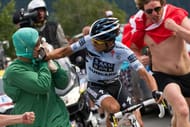
The problem with having a race 3,500 km long is that you cannot avoid the public. The exertion arising from pedalling is perhaps among the lesser concerns of the participants. The audience around the event can be over 12 million spectators, and such a large number of people can cause havoc any moment.
Chris Froome gave us one of the most poignant moments in all of sports when he fell off his bike while climbing the Mont Ventoux at the 2016 Tour. Rather than wait for a replacement bike, which was stuck in the traffic, he chose to run uphill towards the finish line, all rules forgotten. While his timing placed him in sixth position, the judges chose to discount the adverse effect of the crash on his timing and he got to keep his yellow jersey.
Froome's fall was caused by the unrelenting crowd and the motorcycle ahead of him. But he had to face something possibly even worse the previous year, when he had a cup of urine thrown at his face during the 14th stage of the Tour in 2015.
At the 1975 Tour de France, Eddy Merckx was punched by a fan at the Puy de Dome and he ended up losing the race. Back in 1904, the crowd invaded the route to beat up the rival of the local fastman. That incident prompted the founder of the race to write "The Tour is finished.”
That statement might not have come true, but the riders sure do feel finished after the 23-day ordeal.
Calories burnt per minute: 14.02
Sweat loss per minute: 0.03 litres
Duration: 256 minutes
1. Ironman Triathlon
You've probably rolled on the floor in mirth at this viral video of runners waddling to the finish line of a triathlon. But we're all heartless heathens for laughing at this spectacle from the comfort of our couches; we are judgemental potatoes who have no idea what those inspiring athletes were going through in those final moments before the finish line.
The two athletes in this video are Sian Welch and Wendy Ingrahm, crawling to the tape in the 1997 Ironman World Championship. In a sobering scene of logic overcoming pride, Wendy won when she chose to stoop and crawl across the line rather than try and cross it on two feet.
"There is a special mystique about the marathon, for example, because of its length – but that’s just the bit you do at the end of an Ironman,” said Chrissie Wellington, 4x Ironman World Champion.
It seems criminal that an activity so draining can be named with two simple words: Ironman Triathlon. It sounds innocuous, but the agony it inflicts on the participants is indescribable. It would be difficult to dispute that the Ironman Triathlon is by far the most physically demanding sport ever conceived by mankind.
If you complete even one portion of the triathlon, you can pat yourself on the back and feel proud of your achievement. This ghastly ordeal comprises of the following events, in the order mentioned:
1) A 3.86 km swim, followed by
2) A 180.25 km bike ride, and add a
3) Full marathon of 42.2 km as the cherry on top.
Hercules' 12 labours had nothing on this event. You would gladly battle a couple of Nemean Lions if it meant forgoing the marathon portion of this event.
An Ironman triathlete can burn between 5,000-10,000 calories in completing the gruelling event.
Training for any long distance event involves the process of tapering. Before running a marathon, the athletes take time off from their regular training schedule two weeks prior to the event. They gradually reduce their training intensity in order to replenish the glycogen store of the muscles and repair the fatigued tissues.
The Ironman Triathlon wrings you in the grinder through an exhausting swim and a thigh-numbing bike ride before placing you at the starting line of a 42.2 km race. You've already been steamrolled at the commencement of undertaking an event for which athletes rest for two weeks prior.
There is one tiny consolation in that swimming, cycling and running stress different muscle groups with differing intensities, which makes the fatigue metre a touch more manageable. But that's like consoling yourself that a punch to the nose won't hurt as much when preceded by two slaps.
As if the activity isn't testing enough, there is a strict time limit to adhere to if you want the distinction of being called an Ironman. The total duration needs to be less than 17 hours, and there is an individual cut-off timing as well.

Think the CAT cut-offs are tough? Here's what the Ironman Triathlon demands: the swimming portion of the race needs to be completed in 2 hours and 20 minutes, biking portion cannot take more than 8 hours and 10 minutes, and the final distance of 42.195 km needs to be run in under 6 hours and 30 minutes.
Generally, an Ironman Triathlon starts at 6:30-7 AM and continues till the sun goes down. Throughout the course of the race, participants are offered refreshments in the shape of drinks, bananas, oranges and energy bars. All of that just barely helps them to stay afloat.
About halfway through the triathlon, you'll be exhibiting the signs of pain which you'll nurture and grow by continuing on. The entire race is built on the premise of battering your body well after the point of fatigue.
This is by far the most gruelling sport contrived by humans as an excuse for recreation in one day. Even an experienced athlete would require about a week to recover from one of these races.
Disclaimer: This is about the Ironman Triathlon. The triathlon at the Olympics doesn't even begin to compare to this ordeal as it just comprises a 1.5 km swim, 40 km cycling, and a 10 km run.
So there you have the most exhausting sports contrived by humans. Each one is demanding in its own unique way, and all of them put you through the grinder with more intensity than any other sporting activity. If you’re feeling adventurous, try taking up any of these for an incomparable feeling of exhilarating accomplishment.
Calories burnt per minute: 13.89
Sweat loss per minute: 0.03 litres
Duration: 720 minutes
How the ranking was arrived at
| Rank | Sport | Duration (min) | Duration ranking points | Calories burnt | Calories burnt ranking points | Sweat loss (litres) | Sweat loss ranking points | Total ranking points |
| 1 | Ironman Triathlon | 720 | 10 | 10,000 | 10 | 23 | 10 | 30 |
| 2 | Road cycling | 256 | 9 | 3,589 | 9 | 8.52 | 9 | 27 |
| 3 | Marathon | 180 | 8 | 3,087 | 8 | 6 | 8 | 24 |
| 4 | Cross-country skiing | 160 | 7 | 2,627 | 7 | 4 | 7 | 21 |
| 5 | Ice hockey | 60 | 5 | 751 | 6* | 2.4 | 6 | 17 |
| 6 | Australian Rules | 80 | 6 | 857 | 5* | 2.4 | 6 | 17 |
| 7 | Boxing | 32 | 4 | 464 | 4 | 1.07 | 5 | 13 |
| 8 | Basketball | 40 | 5 | 375 | 3 | 1.07 | 5 | 13 |
| 9 | Water polo | 32 | 4 | 374 | 2 | 0.43 | 4 | 10 |
| 10 | Rowing | 8 | 3 | 112 | 1 | 0.27 | 3 | 7 |
* While Ice Hockey burns fewer calories than AFL, that is primarily because the players play less than half of the duration of a match, as they are substituted so often. The sprints in ice hockey, however, are more intense, and the effects of interval sprints are felt long after the culmination of the activity. Sprinting for just 2.5 minutes can end up burning over 200 calories in total, as evidenced by this calorimeter room experiment. That's because the body has to repair the frayed system resulting from the extreme effort.
The calories burnt mentioned in the table above are for the duration of the activity, but the sports involving frequent sprints result in greater exhaustion and total calorie burn throughout the day, hence they are ranked higher.
Additional notes:
1. The numbers for calories burnt are for a 70 kg male, taken from three different sources – NutriStrategy, Treated and Livestrong.
2. The match duration is fixed for boxing, water polo, ice hockey, AFL and basketball. For Ironman Triathlon, marathon, road cycling, cross country skiing and rowing, the average finish times have been considered.
3. Road cycling burns fewer calories than cross country skiing per hour, but road cycling extends for multiple hours over weeks. The figures for calories burnt are on a per day basis for road cycling races.
4. Calories burnt during the Ironman triathlon as cited by Livestrong.com are for completing the entire event. The number could even go above 10,000, depending on the finish time.The sweat rate for Ironman Triathlon has been calculated using the average segmented timings of 1:16 for swimming, 6:25 for cycling, and 4:54 for running.
5. Sweat loss: Sweating can result in dehydration, and even a loss of 2% body weight through sweating causes a reduction in performance by 10-20%. The sweat rate is calculated as the difference in body weight before and after the contest, adjusting for fluid intake.
6. The sweat loss has been averaged based on the numbers available at these sources: ResearchGate, Boxing News, The Conversation, AusSport.gov, Active and Runtri. Sweat loss figures for skiing have been estimated to account for the influence of the cold climate of the races.
What is the foot injury that has troubled Rafael Nadal over the years? Check here






